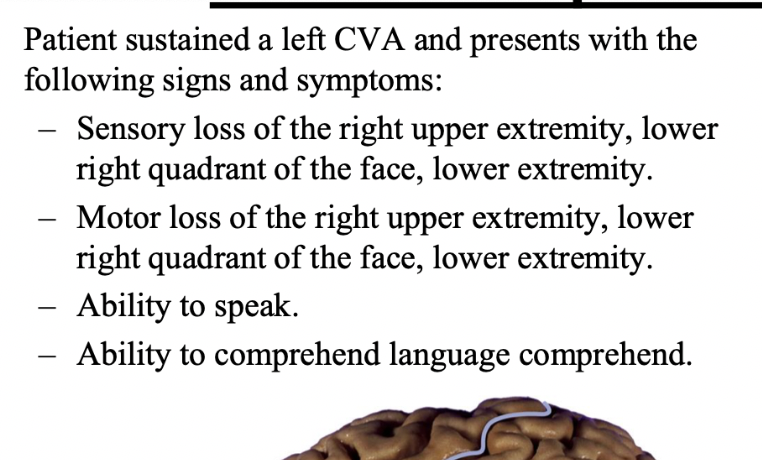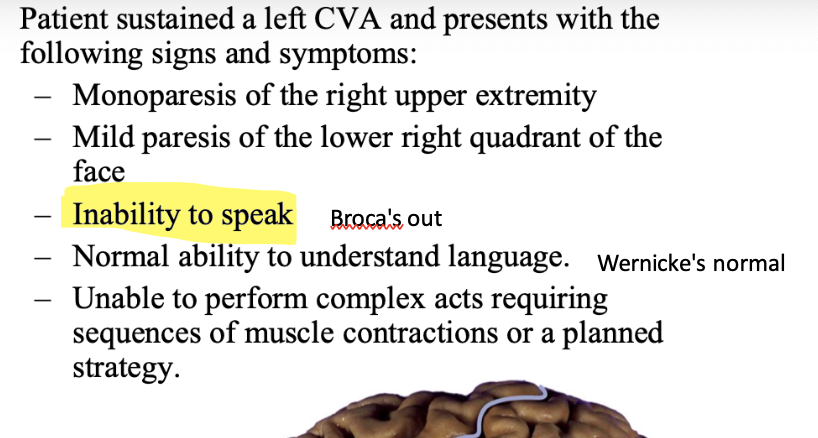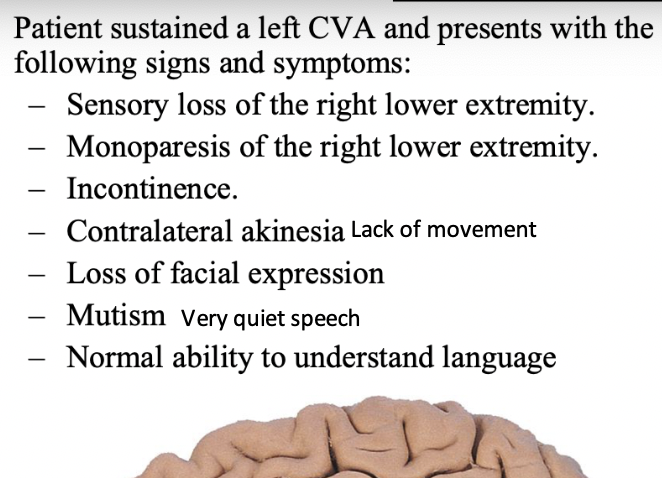Neuro 46: CVA
1/41
There's no tags or description
Looks like no tags are added yet.
Name | Mastery | Learn | Test | Matching | Spaced |
|---|
No study sessions yet.
42 Terms
stroke
interruption of the blood flow to a part of the brain that usually produces a focal loss of function (except in subarachnoid hemorrhage)
sudden onset
focal involvement of CNS
lack of rapid resolution (> 24 hours)
vascular cause
what are the key features of a stroke (4)
occlusive
stroke do to closure of a BV; most caused by atherosclerosis and thrombosis
ischemia
insufficiency of blood supply; if temporary, symptoms and sign may clear with little or not pathological evidence of tissue damage
infarction
severe and prolonged ischemia where neurons die
hemorrhagic
stroke with bleeding from a vessels; most associated with hypertension and aneurysm
extraparenchymal
what type of hemorrhagic stroke causes subarachnoid hemorrhage
intraparenchymal
what type of hemorrhagic stroke may cause a blood clot or hematoma within the hemispheres, brain stem, or cerebellum
transient ischemic attack (TIA)
brief focal loss of brain function, with full recovery from neurologic deficits within 24 hours; 10-30% of people will have a stroke within 3 months
completed
stroke with neurologic deficits from vascular disorders that persist for longer than 1 day and are stable
progressive
ischemic stroke in which some people have deficits that increase intermittently over time
focal
direct infarcted ischemia
penumbra (peri-infarct)
indirect infarcted ischemia; impairs cerebral blood flow, control of CSF, and cerebral metabolism
location
size
structures involved
collateral blood flow
what are the factors that affect the severity of a stroke
superior division of MCA
what supplies broca’s area
superior division of MCA
what supplies frontal eye fields
superior division of MCA
what supplies the motor cortex
inferior division of MCA
what supplies the sensory cortex
inferior division of MCA
what supplies wernicke’s area
inferior division of MCA
what supplies the optic radiation
left
if language cognition is impaired, what side of the brain is the lesion likely on?
right
if the perception cognition is impaired, what side of the brain is the lesion likely on?
anterior choroidal artery
what artery affected if homonumous hemianopia?
leticulostriate
what artery involved?

superior division of MCA
what artery out?

left ACA
what artery damage?

lenticulostriate artery
which artery damaged:
superior internal capsule out
visual fields intact
hemiparesis
hemianesthesia
anterior choroidal artery
which artery damaged:
inferior internal capsule out
homonymous hemianopsia
hemiparesis
hemianesthesia
MCA
what does the lenticulostriate artery typically branch from?
ICA
what does the anterior choroidal artery typically branch from?
unilateral neglect
decreased body or environmental awareness of one side; fails to report or respond to stimuli presented on one side; person appears unaware of half of their body and/or of one side of space
anterior choroidal artery
what artery damaged:

parietal
what part of the brain if unilateral neglect?
primary motor area
where is the lesion?
contralateral weakness or paresis
contralateral spasticity
brisk stretch reflexes
supplemental motor area (internal drive), ACA
where is the lesion and what artery?
contralateral akinesia
mutism
loss of facial expression
difficult with cooperative movements of both hands
trouble performing self-limiting tasks
premotor area (external drive)
where is the lesion?
apraxia
movements are clumsy and slow
rhythmic movements disrupted
perseveration (repeating)
difficulty performing sensory triggered tasks
posterior parietal cortex
where is the lesion?
severe attentional disturbances of tactile or visual stimuli on one side of the body
errors locating objects in space
problems in performing complex postures
unable to recognize complex objects placed in the hand without vision
synthesize spatial coordinates of surrounding objects incorrectly
ACA
where is the lesion?
leg area of primary motor and sensory cortex affected
supplementary motor area (internal drive) affected
motor planning affected
superior division of MCA
contralateral weakness of face, hand, arm
possible contralateral sensory deficit that affects the face, hand, and arm
premotor area external drive; motor planning
apraxia (complex movement)
broca’s aphasia
apraxia
unable to perform complex tasks requiring sequencing of movement
inferior division of MCA
where is the lesion?
possible contralateral sensory deficit that affects the face, hand and arm
loss of stereognosis; extinction
wernicke’s aphasia (lesion left side) - fluent aphasia
neglect (lesion right side)
stem of MCA
where is the lesion?
contralateral hemiplegia
contralateral hemianesthesia
contralateral homonymous hemianopia
global aphasia (lesion left side)
neflect (lesion right side)